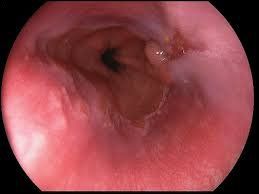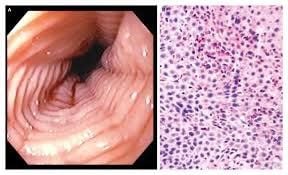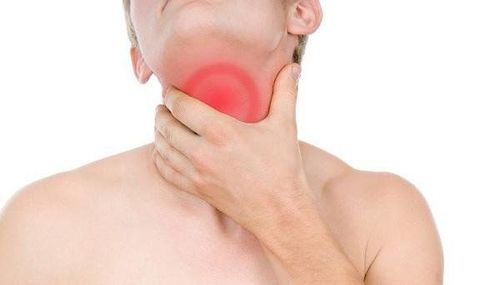This is an automatically translated article.
Article written by MSc Mai Vien Phuong - Department of Examination & Internal Medicine - Vinmec Central Park International General Hospital
Eosinophilic esophagitis (VTQBCAT) is an eosinophilic infiltration of the esophagus that causes clinical symptoms. This is a new disease that has only really received attention in the last 20 years. The first case described by Landres in the literature in 1978 was a case where a patient was initially diagnosed with achalasia and then discovered a thickening of the muscular layer in the esophagus and histopathology showed Eosinophilic infiltrates were found.
1. This patient with eosinophilic esophagitis often has complications
Esophageal stenosis/ring of the esophagus In adults, esophageal stricture lesions are uncommon but can progress to varying degrees with two main forms, narrowing at one location or narrowing over a segment long.
According to some case series reports, the incidence of focal narrow lesions is <10%. Patients with this complication usually progress slowly and the patient adapts by changing the solid diet to liquid foods and eating them slowly.
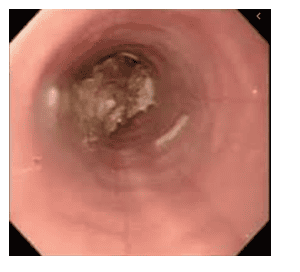
Choking on food Sometimes this is the first symptom of the disease and can be of varying degrees. Patients often find themselves choking after swallowing food and try to let the food down by drinking more water, getting up or sitting down, or doing some strenuous movements.
In the early stages, when using these methods, the patient can stop choking, but there are a few cases where the patient has to go to the hospital when the food does not come down.
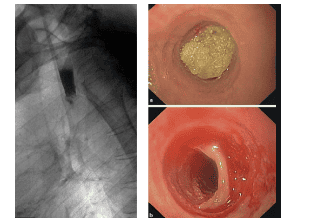
Because of these complications, endoscopists have used balloon dilatation to resolve the strictures.
2. Interventional technique by dilation of the esophagus
Efficacy of esophagectomy in patients with VTQDBCAT has been demonstrated in multiple studies and meta-analyses with a clinical improvement rate of 75%. The time to achieve symptom remission varies from study to study.
Enlargement of the stricture should be considered after failure of medical/dietary therapy. Enlargement of the narrow space in VTQDBCAT is an effective and safe procedure even when using the bougie technique. Savary or balloon angioplasty has a low perforation rate of less than 1%. Occasionally, chest pain after esophagectomy may be noted but is not severe. Stenosis in VTQDBCAT should be combined with long-term medical therapy and/or dietary modification to ameliorate inflammation and prevent fibrosis causing stenosis.
There are 2 dilation sites in eosinophilic esophagitis: esophageal dilatation and achalasia. The principle of dilatation is mechanical force to break the stricture.
3. Esophageal stricture method
3.1 Plastic bougie sockets Bougies of various sizes and metal conductors 1cm long have an anti-reflective marking on the light curtain. Steps to be taken:
Pass the flexible end of the guide wire through the surgical channel and through the narrowing area under the view of the laparoscopic monitor, then check under the luminosity monitor to see if it enters the stomach. Withdraw the endoscope but keep the wire in the stomach and mark the location of the stenosis with metal outside the rib cage and the distance from the narrowing to the dental arch.. Push the bougie slide on the guide wire through the narrowing, do not push the sonde bougie if have moderate resistance or tight or bleed. The frequency of reflux esophagitis depends on the progression of esophagitis and the initial dilation. Principle of bougie dilation: when there is moderate resistance, use only ≤ 3 consecutive bougies with a diameter greater than 1mm in 1 session. 3.2 Balloon dilation Balloon dilatation of different sizes and wires, the steps are as follows:
The procedure begins with, endoscopically checking the narrowing: location, size, associated lesions. Then thread the flexible end of the wire through the interference channel. Slide the balloon catheter over the lead. Check the position of the balloon in a narrow spot (enhanced screen with contrast pump) or on an endoscopic monitor with a guide or small endoscope passing next to the balloon. Inflate the balloon to expand the narrow space to a reasonable extent. Principle: ball diameter should not exceed narrow spot diameter more than 2mm and ≤ 3 times narrow spot diameter. Burn ≤ 3 times in 1 session. Inject 1-2ml of lubricating silicone oil into the intervention channel before inserting the balloon.
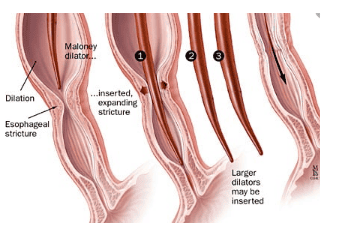
4. Cardiac dilatation method
Instruments: Rigiflex dilatation kit (Microvasive) 1 cardiac dilatation balloon with 2 tubes, diameter of 2 barrel catheters is 5mm, balloon length is 10cm and diameter is 3-4cm.
Implementation steps:
Insert the soft end of the lead wire into the interventional channel through the cardia. Mark the heart of the metal. Withdraw the endoscope but keep the lead in place, then push the balloon to slide over the wire to the cardia. Check the position of the ball at the center of the cardium with the magnifying screen. There are contrast images at the upper and lower ends of the balloon. Inflate the balloon gradually and pull it gently to make sure it is in place during inflation. Observation under the light shows an hourglass-like balloon at the waist of the pressure balloon, which will range from 7-12psi. Single pump with 30mm bulb lasting 45 seconds for children under 12 years of age. For adults, start pumping for 30 seconds with a 30mm ball and then 15 seconds with a 35mm ball. Withdraw the balloon, then inject a small amount of contrast material into the esophagus to control leakage from the esophageal tear. Number of times of dilation: Usually, each patient needs 2-3 times of dilation.
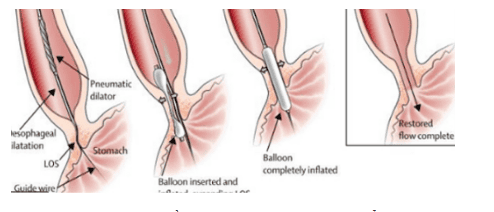
Follow-up after dilation
Follow up: Fever, cough, wheezing, subcutaneous emphysema, poor pulmonary ventilation and resonant percussion, respiratory failure, vomiting blood, anemia, chest pain, abdominal pain, dyspnea. Feed the patient again after 24 hours if the patient has no symptoms of a stroke. Complications and management
If esophageal perforation is suspected, chest X-ray should be taken, when pneumomediastinum, pleural or massive bleeding occurs, surgical consultation and resuscitation should be performed. Esophageal perforation in cardiac dilatation requires immediate surgery to repair the tear and perform Heller's surgery to open the pericardial muscle. Perforation due to gastric dilatation usually occurs within the first 5 hours. Bleeding: Bleeding at the dilation site is common in most patients, but most are mild and self-limited. If bleeding is heavy: endoscopic intervention to inject hemostasis clamp or surgical intervention to stop bleeding. Note:
Always use a lead for the catheter or balloon. Make sure the dilator is in the correct position between the lumen of the anastomosis or the cardia. Do not attempt to enlarge the joint with just one session. If the stricture is not safe for dilation, a consultation with a surgeon should be sought to find another way to treat the patient. Esophageal stricture due to eosinophilic esophagitis is a serious complication, in parallel with endoscopic dilation of the stricture, patients need to combine with medical treatment and diet adherence to increase therapeutic efficacy.
Please dial HOTLINE for more information or register for an appointment HERE. Download MyVinmec app to make appointments faster and to manage your bookings easily.





